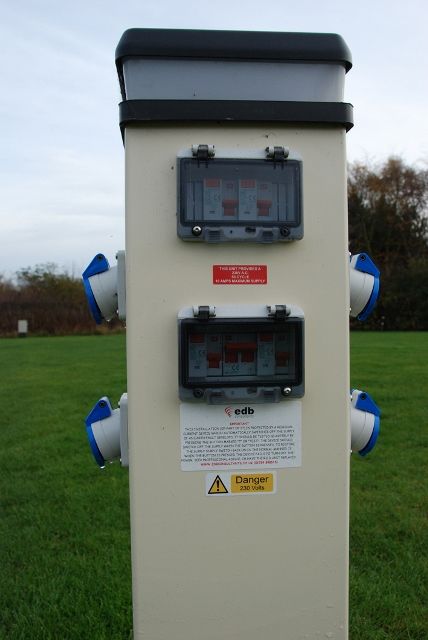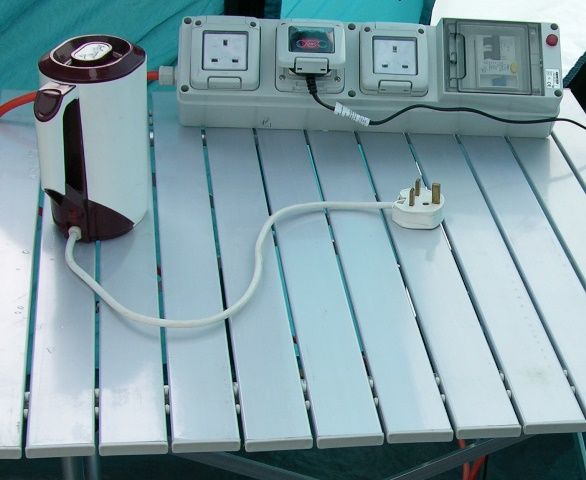Disconnecting
 When you are ready to leave, switch off the RCD in your unit. Disconnect the cable from the hook-up outlet socket on the bollard and then remove the cable from your unit. Owners of motorhomes must not leave their hook-up cable connected to the site bollard as a marker for an occupied pitch when temporarily off site. If you want to mark your pitch with the cable, disconnect it first.
When you are ready to leave, switch off the RCD in your unit. Disconnect the cable from the hook-up outlet socket on the bollard and then remove the cable from your unit. Owners of motorhomes must not leave their hook-up cable connected to the site bollard as a marker for an occupied pitch when temporarily off site. If you want to mark your pitch with the cable, disconnect it first.
Loss of supply
On Club Sites, any loss of supply should be reported to the Holiday Site Manager as soon as possible. If the loss of supply is because you have overloaded the circuit or misused your equipment there may be a charge for restoring your electricity supply. Please do not ask site staff to attend to hook-ups before 9am or after 8pm unless it is an emergency.
On other sites
Not all campsites are run to the same high standards as those of the Club, but all should have their electrical supply checked each year and hold a certificate showing the supply has had its annual inspection. If in doubt about a hook-up, speak to the site owner before connecting up.
How much power?
Most Club sites are able to provide a 16A electrical supply, but some are limited to supplying 10A. Certificated Sites and other campsites’ supplies maybe even more limiting, perhaps providing as little as 5A. In comparison, a modern domestic kitchen typically has a power supply of 20A, plus a separate electric cooker supply and a lighting supply. Hence, when camping, to keep within the limits of the campsite supply and prevent a loss of supply if a circuit breaker trips, you need to be careful about the appliances you use and how many you use at one time.
You need to ensure the total rated wattage (rated power) of equipment switched on at any one time is less than the power supplied to you. Power (in W) = voltage (in V) x current (in A), so for a 10A hook-up, 230V x 10A = 2300W, hence 2,300W (2.3kW) of power can be supplied to your unit. At a 16A site this rises to 3.68kW. Particularly beware of using ordinary domestic kettles that can draw 10A or more on their own. Special low wattage kettles and other equipment are available from camping and caravan dealers. Microwave ovens can also present problems – even though they may be advertised as (for example) 800W, the input operating power requirement, particularly on start-up, may be up to twice this.
Even though you may have a 16A hook-up, the power sockets in your caravan or motorhome may be protected by a circuit breaker of just 10A. Usually there is another one or more circuits rated at perhaps 6A or 10A, which covers the lighting circuit and possibly some other built-in electrical equipment. If in doubt consult your handbook or contact your dealer.
The supply on Club Sites (and most other campsites) is designed on the basis of diversity so the main site supply is geared up to an average electrical usage, not all hook-ups taking 16A at one time. Just occasionally, if a cold spell occurs at times of high occupancy and all users switch on electrical heaters and kettles at the same time, you may suffer reduced power or even a power cut, so it is important to use electricity responsibly.
Electrical consumption table
This table shows how many watts (W) and amps (A) normal appliances may require. It is only a guide and the power ratings marked on your appliances should be used wherever possible.
| Appliance |
Power (W) |
Current (A) |
| Domestic kettle |
2,000 |
8.7 |
| High-speed kettle |
3,000 |
13.0
|
| Iron |
1,300 |
5.6 |
| Camping kettle |
750 |
3.3 |
| Microwave oven 800W cooking power |
1,000 |
4.4 |
| Domestic fan heater 1kW |
1,000 |
4.4 |
| Domestic fan heater 2kW |
2,000 |
8.7 |
| Truma water heater |
850 |
3.7 |
| Truma water heater |
1,300 |
5.6 |
| Camping fan heater |
750 |
3.3
|
| LCD TV |
45 |
0.2 |
| Refrigerator |
135 |
0.6
|
| Battery charger |
100 |
0.4 |
|
Battery charger
|
300 |
1.3 |
| Hair dryer |
600 |
2.6 |
| Hair dryer |
1500 |
5.2 |
|
Toaster
|
900 |
3.9 |
Electricity in tents and awnings

Using a proprietary electric hook-up device in a tent
UK wiring regulations require special measures if electricity is to be used in outdoor locations and as conditions in tent and awnings can often be damp and affected by condensation, it is only sensible to take special measures in these situations.
Details of the hazards and ways of minimising the risks are outlined in the Club leaflet Using Electricity in Tents. The important thing to remember is that water and electricity do not mix. Even small amounts of water or condensation in conjunction with an electrical supply will result in a risk of nuisance tripping, fire or electrocution. Keep all electrical equipment off the ground and be prepared to stop using electricity when conditions are damp. Use electricity only when someone is present and unplug appliances and replace the covers over the socket outlets when you leave the tent.
Because of these special conditions it is essential to use a proprietary electric hook-up device, manufactured specifically for tent hook-ups. These devices have one, two or three domestic-style three-pin socket outlets and a control box with safety features incorporating miniature circuit breakers (MCBs) and a residual circuit breaker (RCD). Do not forget to test the RCD each time you connect up. Its worth noting the cable will likely be the lower grade 1.5mm sq CSA and only be 15m long so consideration should be made for pitching and electrical power consumption. Always unwind the cable fully before use.
Remember also that most appliances you use will have been designed for the domestic environment and may therefore be vulnerable to condensation.
Maintenance
Most new caravans and motorhomes will carry a three-year National Caravan Council approval certificate covering the electrical installation. However, some imported caravans and most trailer tents will not carry any kind of certification. The Club strongly recommends you have these units checked and all mains electricity installations should be inspected regularly by a qualified electrical technician.
The Electrical Safety Council recommends caravans should undergo testing with an Electrical Installation Condition Report (EICR) at least once every three years. Approved Workshops are qualified to undertake this check, but if your caravan or motorhome dealer does not have a suitably qualified person to provide a EICR then contact either the National Inspection Council for Electrical Installation Contracting or the Electrical Safety Council for a list of suitable personnel in your area.
The Club does not require the production of an EICR certificate with any kind of camping unit but recommends members obtain one.